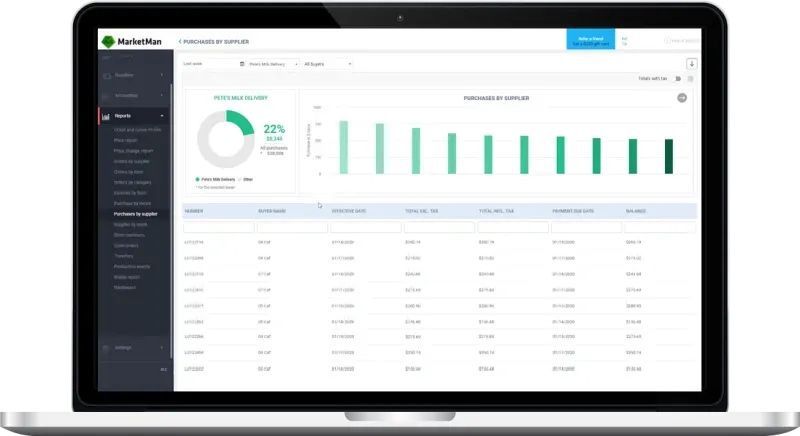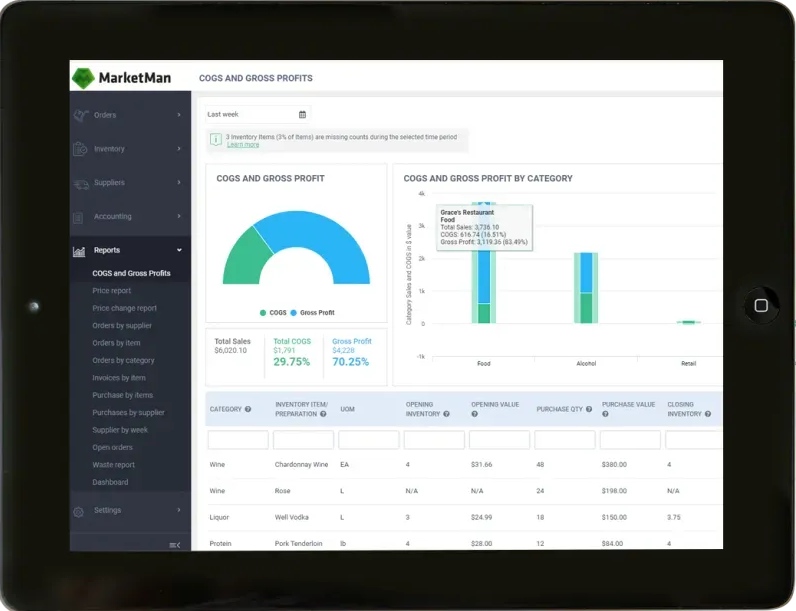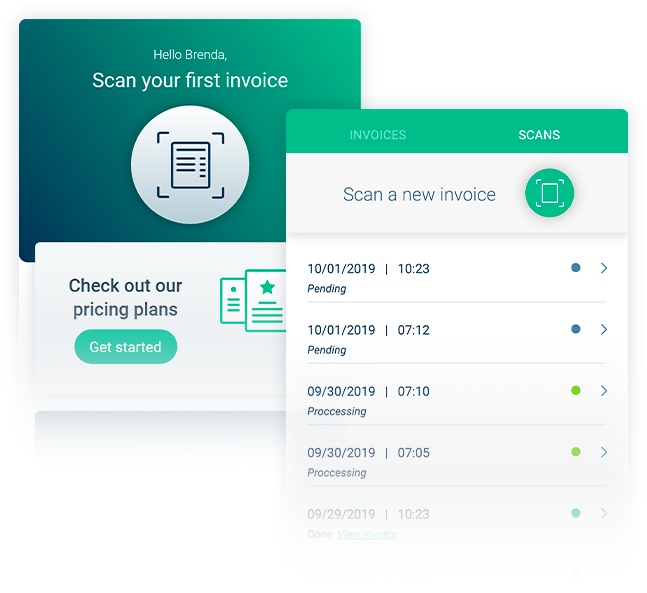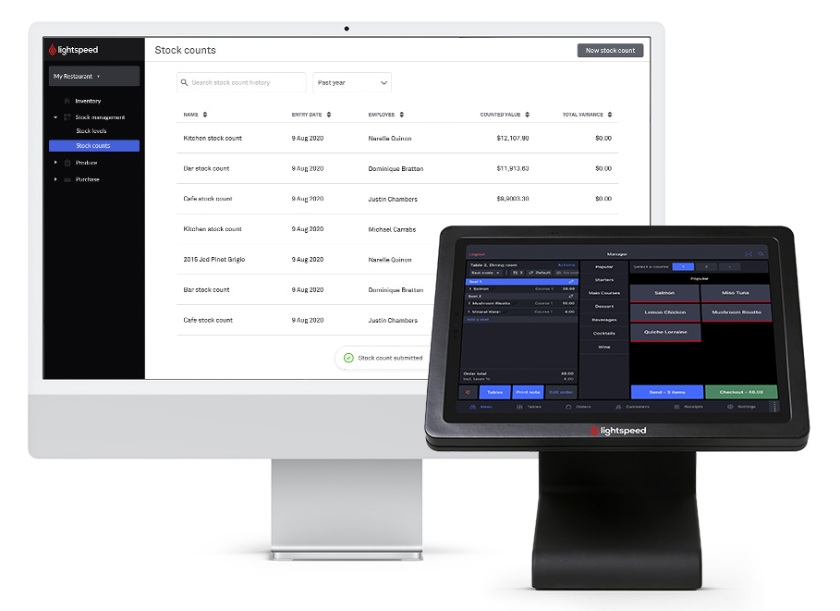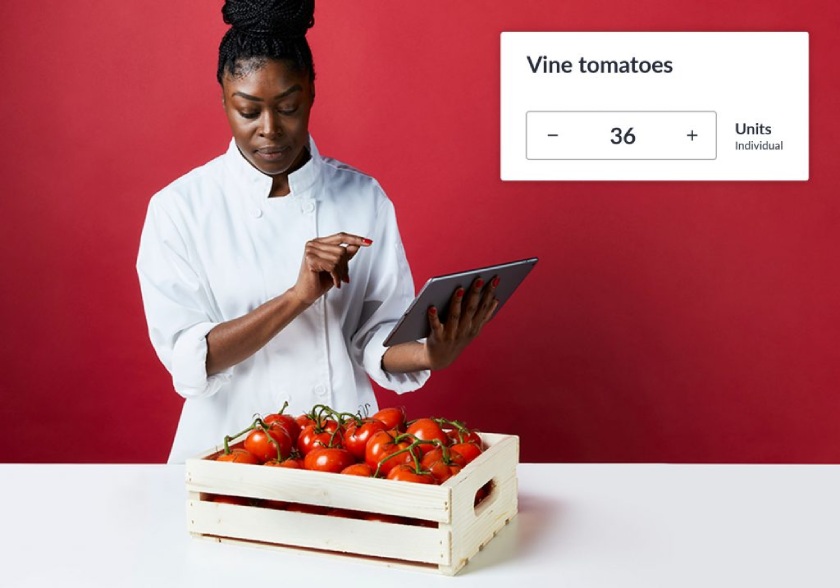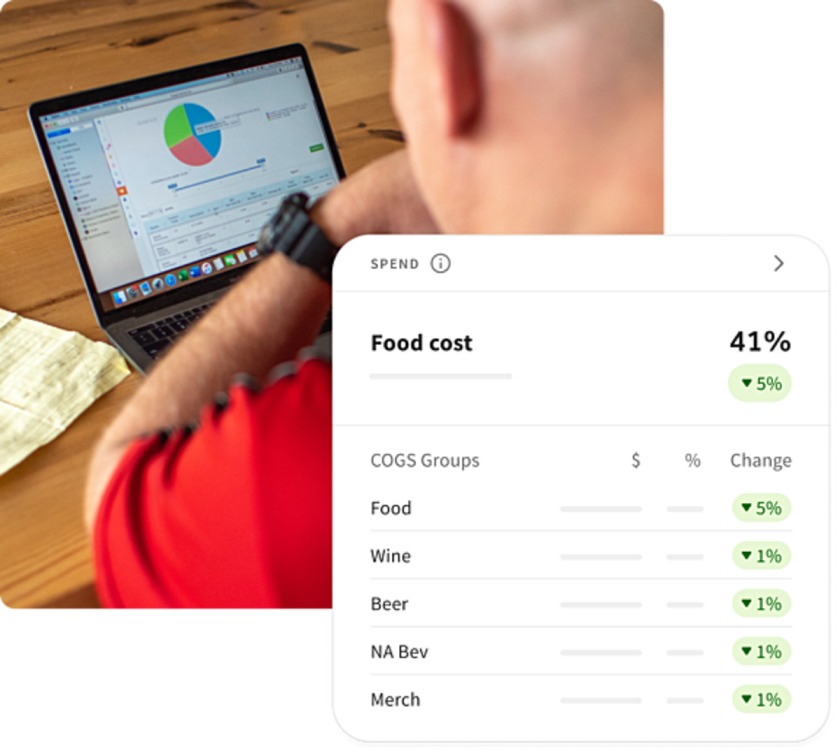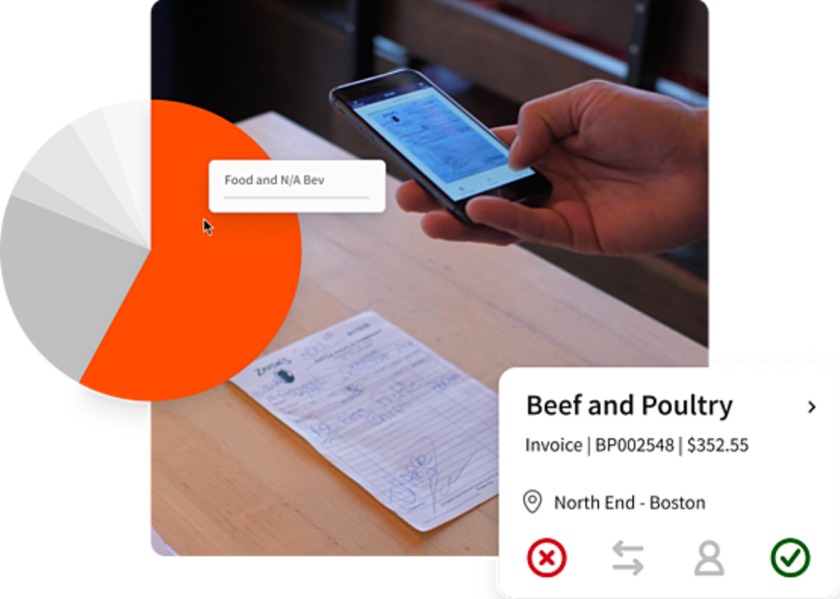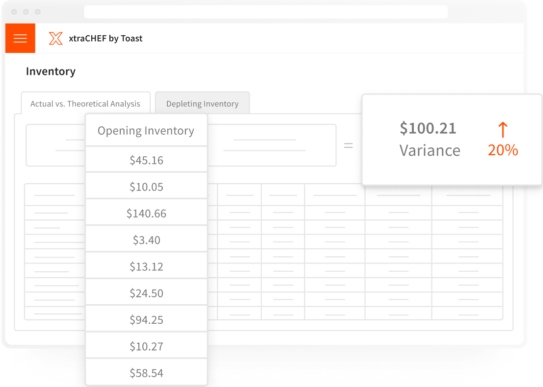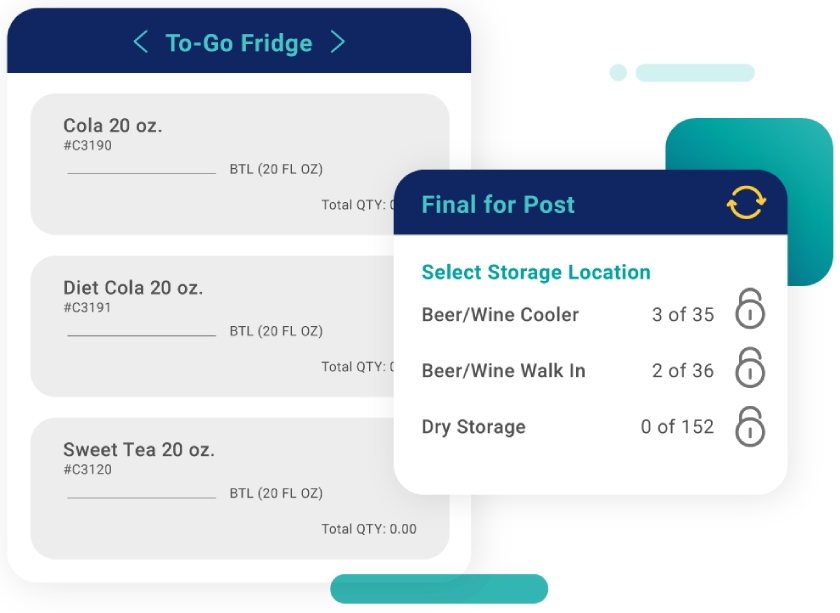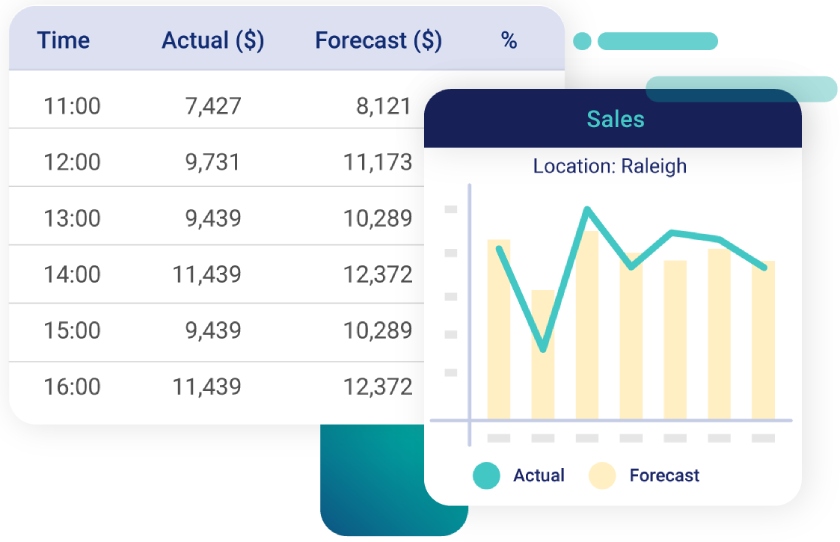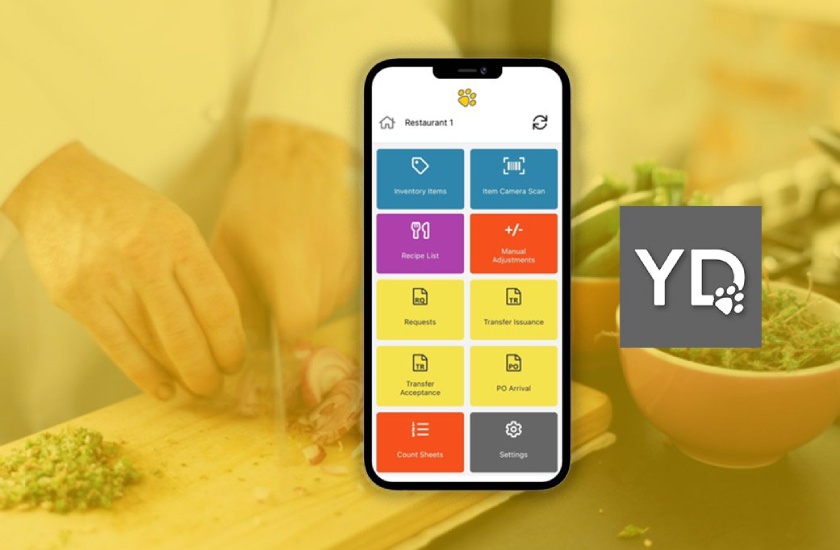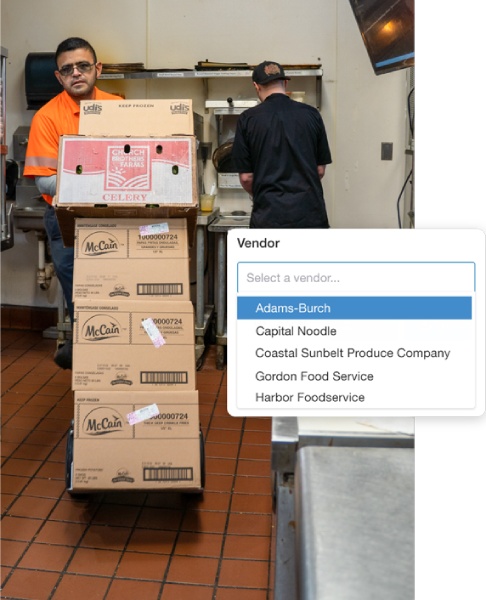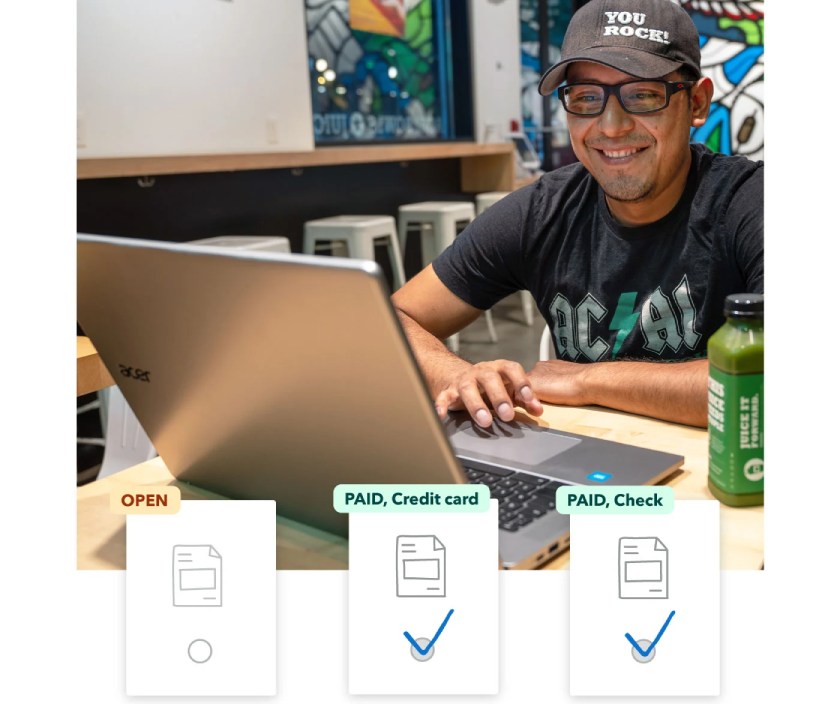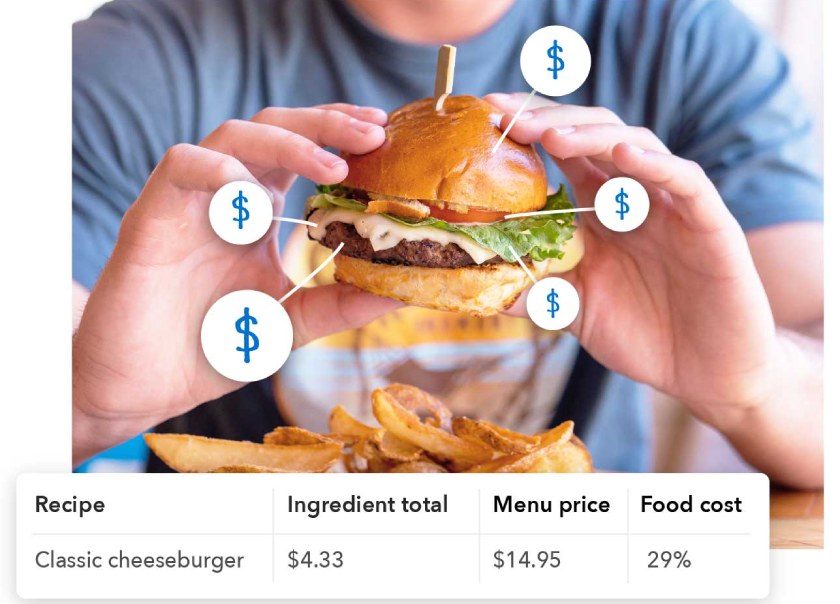Restaurant inventory management software saves hours of admin work, provides crucial information on your par levels, and even alerts you to pricing changes for goods. These systems enable proper inventory management, which keeps costs down, products fresh, and guests happy. The best restaurant inventory management software systems sync with or are built into point-of-sale (POS) systems.
Based on my evaluation, the best restaurant inventory management software are as follows:
- MarketMan: Best overall restaurant inventory management software
- Lightspeed Restaurant: Easiest to use POS-built inventory
- xtraCHEF by Toast: Best for rebates
- Crunchtime: Best for overall cost control
- Yellow Dog: Best for catering businesses & pour-limited bars
- MarginEdge: Best for smaller restaurants
Inventory Management Systems Compared
Our Score (Out of 5) | Minimum Monthly Cost | Contract Length | Management EDI | |
|---|---|---|---|---|
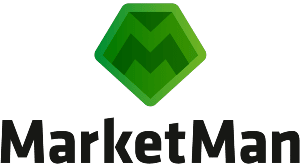 | 4.70 | $239 | Month-to-month or 1 year | Yes |
 | 4.70 | $189 | 1 year | No |
 | 4.50 | $0 | Not disclosed | Yes |
 | 4.39 | Custom quote | 1 year | Yes |
 | 4.36 | Custom quote | Month-to-month or 1 year | Yes |
3.85 | $330 | Month-to-month | Yes | |
All providers’ mobile systems work on iOS and Android. | ||||
MarketMan: Overall Best Restaurant Inventory Software

Pros
- Offers personalized user assistance
- Has robust POS and accounting integrations, such as QuickBooks
- Updates inventory per transaction
- Has suggestive ordering feature, great for chefs new to inventory and ordering
Cons
- May be more technology than smaller operations need
- Can be expensive if you need a lot of invoice scans
- Has higher-priced base tier and installation fee
Overview
Who should use it
MarketMan is great for any restaurant setting, but its robust assistance and features make it ideal for new operators managing inventory at busy locations.
Why I picked it
MarketMan’s advanced inventory features, such as EDI-integrated vendors, detailed inventory reporting, and a very functional mobile app, make it our top pick. Niche tools, such as allergen tracking and by-sale reporting, set MarketMan apart from others on our list.
MarketMan offers nearly all the features you need to accurately track and account for your restaurant inventory. The software is also very easy to use and offers in-depth training sessions for new users. However, the base price tier and installation fee can be a lot for smaller businesses.
Monthly Software Fees:
- Operator: $239
- Professional: $299
- Ultimate: $429
Installation Fee: All new users are also charged a one-time installation fee; previously we were quoted $500 for installation; check with MarketMan for current fees.
- One-on-one setup: When you sign up for MarketMan, you’ll be assigned a dedicated account executive. This rep will help walk you through installing and setting up your account and tuning the software to your business’s specific needs.
- Maximum food cost threshold: In the app, you can set a maximum food cost for each recipe. This then tracks ingredient prices, alerting you when the recipe goes over the cost. This is super helpful when trying to track or lower food costs.
- Vendor integrations: MarketMan comes with prebuilt integrations to 10 mainline distributors, such as Sysco and US Foods. These are an extra cost per month unless you have the Ultimate plan. This integration allows for easier order placing, credit tracking, and price analysis per ingredient.
- Cloud-based inventory: MarketMan tracks your data in the cloud, allowing you to take inventory counts on whatever device you’d like. This proves useful when multiple stakeholders are taking inventory counts in your restaurant.
- Staff task tracking: In the dashboard, you can assign access levels to different staff members to delegate inventory responsibility. This tool will send you reports on their counts—especially handy in case of errors or discrepancies.
- Suggestive Ordering: One of MarketMan’s newest features is suggestive ordering. This new feature uses historical sales, purchasing, and inventory data to offer an intelligent ordering forecast for your business. This can be extremely helpful for restaurants trying to establish and tighten up inventory par levels in their kitchen.
- Personalized assistance: MarketMan’s team of professionals is there for multiple rounds of training calls or demos, ensuring you get the software set up for your business. This extra layer of assistance is great for new users looking to truly maximize the inventory software they are paying for.
Lightspeed Restaurant: Easiest to Use POS-built Inventory

Pros
- Fully integrates into Lightspeed Restaurant’s POS system
- Has Auto-86 feature that sets items on the menu as unavailable when necessary components are out of stock
- Has one-click reordering that makes resupplying inventory foolproof
Cons
- Requires Lightspeed’s POS software, which does have a pricey base cost
- Has no free trial to see if both the POS system and the inventory software are good for your business
- Does not support true EDI vendor integrations
Overview
Who should use it
Restaurant operators looking for a new POS system or wanting to switch to a more comprehensive POS software will find value in this option.
Why I picked it
Lightspeed Restaurant’s POS software is one of the best and most comprehensive on the market. The same can be said for its inventory feature, now included in the base software plan. It has a variety of advanced features for managing complex inventories. You can personalize the platform to your liking, track recipe costs with live ingredient pricing updates, and even automate recurring orders based on your needs.
Lightspeed is ranked below MarketMan simply because it is not a standalone inventory system—it requires you to use the POS system. Lightspeed Restaurant also locks you into a contract. So while it is not as flexible, Lightspeed Restaurant’s inventory tools offer everything you need for in-depth inventory management.
- Monthly subscription plans*:
- Essentials: $189
- Premium: $399
- Enterprise: Custom quote
* Prices are lower for users who pay fees annually and enroll in Lightspeed Payments.
- Installation fee: None
- One-click reordering: Lightspeed Restaurant depletes your on-hand inventory count as you sell items throughout the day. As supplies dwindle, your POS sends low-stock alerts and generates suggested orders from your suppliers. You can review these orders and submit them all with one click in your back-office dashboard. Lightspeed Restaurant is the only tool on this list with a one-click reordering feature.
- Smartphone scanning: You can download the Upserve Inventory App from the App Store and Google Play and transform your smartphone camera into a barcode scanner to receive and count inventory items.
- Color-coded order alerts: Orders change color in your inventory dashboard so you can see at a glance when a vendor order has been submitted, received by the vendor, delivered, and completed. You’ll see your order status change in real time as suppliers open and read your order emails and text messages.
- Offline functionality: We all know the walk-in cooler has zero internet connection. Lightspeed leverages the POS system’s robust offline functionality to support inventory counts on mobile devices. When you lose internet connection, the system saves updated item quantities in your mobile device’s local cache.
- Auto-86’ing: Since the inventory tools are built into the POS, the Lightspeed U-Series can automatically 86 menu items you sell out of. Many freestanding inventory tools like MarketMan lack this feature. This helps prevent customers from ordering items that are actually no longer available—a major pain point in restaurant operations.
- Recurring orders: Lightspeed Restaurant allows you to place recurring orders automatically, with editing functionality as needed. This keeps necessary pars up to their sufficient levels without the hassle of worrying each time one runs low.
- Margin and cost tracking: Lightspeed Restaurant helps track cost by ingredient in each recipe. As pricing data changes, so does the cost of your recipe overall. Furthermore, Lightspeed uses the sale price to showcase the margin you are getting on each dish, allowing you to make decisions with real-time, inventory-based data.
xtraCHEF by Toast: Best for Rebates

Pros
- Includes vendor EDI integrations for orders and payments
- Integrates directly with Toast’s industry-leading POS system
- Has affordable base POS software to access the inventory tool
Cons
- Is locked into Toast’s POS system
- Has pricing that is not publicly listed and contract lengths that tend to be longer than competitors
- Has limited available integrations
Overview
Who should use it
For restaurants with a lot of people counting inventory or managing inventory across multiple locations, xtraCHEF is a great choice. Also, those focused on getting rebates will appreciate this functionality in Toast.
Why I picked it
Toast’s POS software is among the best in the food industry—it is our overall top pick for restaurant POS—and its inventory feature is no different. xtraCHEF is a fantastic choice for those who own Toast and want to add inventory management software to their business. Alternatively, those looking for a POS system with inventory management will be pleased with Toast. Its rebate program is the most robust in the industry and can help save operators a ton of money.
Note that the system is tied to a Toast subscription, which is two years. The lack of barcode scanning functionality holds the system back from a higher score.
Monthly software fees:
- Starter Kit: $0
- Point of Sale: $69
- Build Your Own: Custom quote
Installation Fee: You can typically self-install a simple Toast POS system following Toast’s excellent online tutorials and guides. For more complex installations, you’ll need on-site assistance, which requires a custom quote from Toast.
Currently, adding xtraCHEF by Toast to your POS requires a custom quote. You’ll need to talk to a Toast sales representative to get a complete idea of your total costs.
- Rebate program: Your xtraCHEF system will check your orders against manufacturers’ rebates available on the Buyer’s Edge platform. This rebate program helps ensure you’ve gotten the best price and earn some cash back whenever possible.
- Visual interface: xtraCHEF’s dashboard is designed to be visual-first. Reports condense complex cost analysis into easy-to-read charts, so there is no chance of misreading your metrics.
- Invoice scanning: Like MarketMan, xtraCHEF includes invoice scanning tools for easy invoice entry. Unlike MarketMan, however, there is no limit to how many invoices you scan each month with xtraCHEF. The more you scan, the more intelligent your xtraCHEF system becomes.
- EDI functions: Like MarketMan, Crunchtime, and Yellow Dog, xtraCHEF includes a full EDI connection to place orders and place payments with suppliers directly from your xtraCHEF dashboard.
- Accounts payable automation: Lost invoices can cost businesses money. xtraCHEF digitizes invoices in the cloud, where they can be easily searched on desktop and mobile devices.
- Variance reporting: Toast is great for variance reporting, which allows you to see when inventory is not right or has an error. This can be huge for restaurants in which many different people count inventory or when inventory is taken across multiple restaurant locations.
Crunchtime: Best for Overall Cost Control

Pros
- Offers 1,000-plus integrations including popular restaurant POS and accounting software
- Has counter mobile app for extremely accurate inventory tracking
- Has accurate sales forecasting that helps determine how much inventory you need on hand
Cons
- Has custom-quoted pricing that is not publicly listed
- Is a bigger system than some smaller restaurants may need
- Has limited support and customer service hours
Overview
Who should use it
Crunchtime is great for operators looking for deep, useful cost-control tools, including in-depth cost analysis of inventory.
Why I picked it
Crunchtime is your best bet for knowing and controlling food costs. I personally would pick Crunchtime, as cost control was a key focus I prided myself on during my experience managing restaurants. The software is so popular that brands like Five Guys and Chipotle even use it.
Advanced inventory features, such as adaptive inventory forecasting, focus on managing costs and ensuring you have the correct amount of inventory on hand. Crunchtime also has the ability to integrate with over a thousand POS software integrations. Only custom quotes on pricing and installation set Crunchtime back in my evaluation.
- Custom-quoted: Crunchtime doesn’t list pricing publicly; you’ll need to contact them for a custom quote. The drawback is that every custom quote takes time and it can be hard to tell if you are getting a good deal. On the other hand, a custom quote lets you customize your software and only pay for the tools you’ll actually use.
- Installation fee: The installation fee for Crunchtime is also a custom quote.
- Detailed analytics: You can customize your Crunchtime dashboard and alerts to track what data you see. POS integration allows you to track profit and loss (P&L) in real time, so you can make critical business decisions in time to impact your bottom line.
- Crunchtime Impact: This attached mobile reporting app shows up to 50 KPI metrics on any mobile device. Impact works on Android and iOS devices and even integrates with Apple Watches, so information can be relayed immediately to those who need it most.
- In-depth order suggestions: Crunchtime’s suggested ordering pulls relevant data and smart forecasts ahead, helping you determine what exactly is needed. This tool is vastly helpful for newer restaurant managers and is why multiunit locations may prefer this service.
- Counter: This app is available on different mobile app stores to download and is a great tool for in-depth inventory management. You can use this app to have multiple users take inventory on the same count sheet, reducing time spent in total.
- Sales forecasting: This tool can help determine prep levels and coincide with the suggested orders for your restaurant. The Crunchtime ecosystem allows you to prep and order the right amounts, saving you money while keeping your inventory tracking organized and easy to access.
Yellow Dog: Best for Catering Businesses & Pour-limited Bars

Pros
- Has monthly subscription
- Integrates Freepour for bar inventory tracking
- Integrates with accounting software such as QuickBooks
Cons
- Has custom-quoted pricing
- Has no 24/7 live customer support
- Offers setup training for a fee
Overview
Who should use it
Caterers and businesses that run ghost kitchens will find tremendous value in Yellow Dog. Additionally, restaurants that offer limited-pour bars will find use in their Freepour integration.
Why I picked it
Yellow Dog offers detailed inventory tracking and integration of Freepour, a bar inventory software. It can update your physical inventory costs in real time, allowing you to see what’s on hand and the cost of goods sold at any given moment. Another feature ideal for caterers is its focus on commissary operations, where you can request production worksheets from these kitchens and have your inventory updated for a catering event per the report.
The system’s focus on real-time updates, available vendor integrations, and multiunit or commissary kitchen support earned it points in my evaluation. However, I docked it for a lack of transparent pricing and some shaky user reviews.
- Custom-quoted: Yellow Dog doesn’t list pricing publicly; you’ll need to contact them for a custom quote. While custom quotes tend to take time, they let you customize your software and only pay for the tools you’ll actually use.
- Installation fee: The installation fee for Yellow Dog is also a custom quote.
- Detailed barcode label printing: Yellow Dog’s barcode printing system supports design templates for an unlimited number of barcode label types. You choose what information to include, from ingredients and price to nutrition information, expiration date, and graphics.
- Commissary kitchen support: If you supply multiple locations with prepped food from a central kitchen—commonly called a commissary kitchen—you have unique product tracking needs. Yellow Dog allows you to create internal transfers of prepared items like fresh juice blends that deplete your commissary inventory based on the attached ingredients.
- Freepour integration: Yellow Dog is the only system on this list that integrates with Freepour, an app that counts liquor with barcode scans and an integrated scale. Because of this, there is no chance that your liquor counts will be off. You can know exactly how much wine, beer, and spirits you have served down to the last drop.
- Connect to suppliers via EDI: As xtraCHEF, Crunchtime, and MarketMan, Yellow Dog Inventory integrates directly with the most popular restaurant suppliers via EDI. This integration downloads your vendor invoices automatically and adds them to your inventory system. Set up invoices to be processed automatically or require manager approval before posting.
- Rugged hardware: Yellow Dog sells inventory counting devices that are as user-friendly as smartphones but much more secure and drop-resistant. If you don’t want to spend the money, though, you’ll find Yellow Dog’s inventory counting and reporting apps available on both iOS and Android devices.
MarginEdge: Best for Smaller Restaurants

Pros
- Has no installation fee
- Allows invoices to be inputted, even if handwritten
- Has same-day budget tracking reports that support quick decision-making
Cons
- Has no robust customer support
- Does not support barcode scan counts
- Is pricey compared with competitors
Overview
Who should use it
MarginEdge is great for smaller restaurants that need a tool that is easy to learn and will cover the necessities of inventory tracking for their business.
Why I picked it
MarginEdge is a great inventory management option for smaller restaurants. With a ton of great customer reviews, this software is highly regarded for smaller to medium-sized restaurants.
While it may lack some of the more advanced inventory features others in this guide have, it does have very intuitive tracking software that may be all that you need when managing a smaller inventory. Price change alerts, year-over-year comparisons, and other useful features make MarginEdge a solid pick for managing your inventory. Lacking in-depth inventory tools and some customer service support cost it some points in my evaluation.
Monthly Software Fees:
- MarginEdge: $330
- Freepour + MarginEdge: $480
Installation Fee: $250 one-time setup fee, custom-quoted for groups with 5-plus locations.
- Invoice processing: MarginEdge makes it easy to process invoices. You can send pictures to be processed, regardless of whether they are typed or handwritten. All of your invoices are processed within 48 hours, saving you a lot of time on admin work.
- Inventory counting: Done on your smartphone, inventory counts can be done in low Wi-Fi settings such as a walk-in. Counts can be received in various packaging types and will be converted to your total count in MarginEdge’s inventory system.
- Growth tools: While this software is great for a single restaurant, it supports growth in commissary support and multiunit transfers. MarginEdge treats commissary kitchens as separate businesses, allowing you to manage inventory and costs easily and in an organized and compartmentalized way.
- Accounting and credit tracking: MarginEdge helps restaurant managers track credits and ensure all invoices are paid on time to the correct vendor. Managing accounting work can be tough for small business owners, and MarginEdge alleviates this burden with robust accounting management tools for the restaurant business.
- Freepour inventory: MarginEdge provides Freepour, an alcohol-focused inventory tracker for an extra fee. This inventory tracker can be huge for operators managing liquor inventory, as the cost for mistakes is much higher in this product type.
How to Choose a Restaurant Inventory Management Software
Choosing a restaurant inventory management software is an important task that helps set your business up for success. This type of software alleviates your business’s many administrative tasks, making it easy to know how much product you have on hand. This, in turn, gives you better control over costs and a better way to serve your customers.
Below are some of the steps you should take when deciding on the best inventory software for your restaurant.
Step 1: Assess Your Current POS and Budget
For starters, if you are using a POS system, chances are they may have an inventory software built in. For example, if you use Toast or Lightspeed Restaurant, you already have the tool to track inventory. If your POS has subpar inventory management software, then assess how much you are willing to spend to have this service for your restaurant.
Step 2: Account for the Size of Your Business
The next step is understanding the size of your business to pick the right software for you. For example, if you manage many commissary kitchens, choosing a service like Yellow Dog is a good bet for the best functionality. If you do not need many multiunit tools, software such as MarginEdge may be a better fit.
Step 3: Determine the Support You May Need for Setup
Some restaurant inventory management software offers extensive support for setup and use, while others may only offer the bare minimum. For example, MarketMan features robust setup support and can be great for those new to inventory tracking software. Your comfort with using this type of technology and what each company has to offer regarding support will dictate which one you decide to commit to.
Step 4: Determine Your Ideal Contract Length
Some restauranteurs may decide they do not want to commit to inventory management software for an extended period. Being aware of the time commitment to the software you are considering is key. Taking advantage of free trials to see what tools truly matter to your business is a great way to find the best software for you.
Step 5: Use Your Chef Community
My last suggestion when choosing an inventory management software for your restaurant is to ask your local chef community what they use. Getting recommendations from chefs who run businesses similar to yours can give you a key understanding of which services may be the best fit. Using your local chef community is always a great idea to get firsthand recommendations.
Step 6: Align With the Features You Need
The last step in choosing the best inventory software management system is ensuring that whatever system you choose offers the features you need to be successful. For example, if you require barcode scanning, then choosing a system that supports this inventory tracking feature is the choice you need to make. When you choose the system that offers your desired features, you are making an investment that truly meets the needs of your business.
How We Evaluated Restaurant Inventory Management Software
I have worked with many different inventory software systems and have also managed a restaurant without one. Without this software, hours of work are added to your plate, and I simply could not imagine not using software like this in restaurant management. That being said, I considered the following criteria to rank the different software providers in this guide.
15% of Overall Score
30% of Overall Score
These included live sales tracking, count sheet accessibility, cloud access, low stock alerts, outside tech integrations, and more. The features in this section should be ones every modern inventory software should account for.
30% of Overall Score
Advanced features considered in this review included barcode scanning, mobile count abilities, order forecasting, vendor management, and EDI integrations. These advanced features are what separate basic software from those more tailored to successful restaurant operations.
15% of Overall Score
Ease of use was determined by customer service hours, online support, provided training, and the ease of setup for each software.
10% of Overall Score
User reviews determined the expert score, the value compared with the cost of the software, the general functionality of the whole product, and how popular the service is in the industry.
Meet the Experts
 | Ray Delucci has 10 years of food industry experience and has managed full-service restaurants and large events and has worked in food development as well. His experience in different restaurant industry sectors gives him insight into what a quality POS needs. |
 | Mary King has worked in every food service business from coffee shops and pizzerias to full-service fine dining restaurants. With over 14 years of industry experience, she has used many POS systems in real-world food service businesses. |
 | Meaghan Brophy has 10-plus years of retail experience, during which she has operated a variety of cash registers and POS systems in different settings and applications. Since working in retail, Meaghan has 7-plus years of experience writing for retailers and 4-plus years of experience evaluating POS systems. |
Frequently Asked Questions (FAQs)
Below are the most commonly asked questions users have when it comes to restaurant inventory management systems.
Restaurant inventory management allows for easy tracking of the goods you have on hand, which in turn lets you more effectively control costs. This software also alerts you to low-stock alerts and price changes. The many tools a restaurant inventory management software provides can easily change how effectively a restaurant is managed.
Restaurant inventory management software tracks inventory, invoices, and pricing of restaurant goods. This software can also track invoices, integrate with vendor ordering, help offer tools to manage multiple locations, and much more. Robust systems offer in-depth inventory analysis, making these tools highly effective for managing restaurants.
An effective restaurant inventory management software is effective when it tracks inventory and invoicing properly while also giving restaurant management clear data they can act upon on a variety of topics. Furthermore, inventory software can give a much more detailed cost analysis for a business, making it easier to take steps to become more profitable. These software also save time, making them invaluable for many food businesses.
The main benefit of inventory management software for restaurants is the cost savings these systems provide. This software helps track when items are expiring, when more of an item must be ordered, and can do a variety of other tasks. On top of this, your food quality is always better because of using fresh ingredients that are tracked by the inventory software. Cost savings, food quality, and easier operational control are all benefits associated with restaurant inventory management software.
Bottom Line
Finding an inventory management software that works for your restaurant can be the key to unlocking savings and bettering your overall operation. The best inventory management software systems give you a detailed view into your par levels ingredient pricing and relay to your staff when orders need to be placed.
All of these features and more are found in MarketMan, as it continues to be the leading inventory management software for restaurants. With plenty of features to keep your inventory on track, we suggest it as the best on the market for restaurants that need to manage their inventory.
